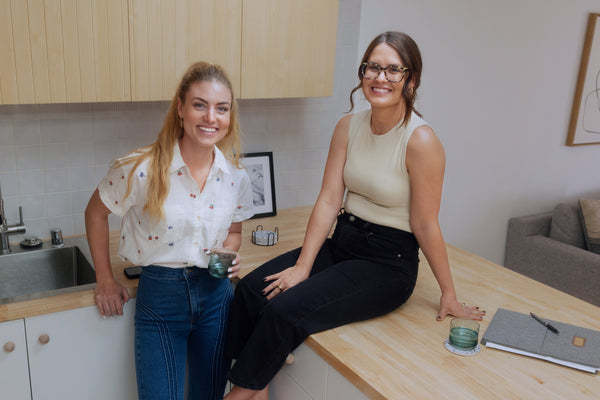By Mariah Wood
The Origin Story of Our Non-Alcoholic Cocktails
I regularly get the question, “How did Tilden come to be?” or “What inspired you to build a beverage company?” The journey began at Harvard Business School where Vanessa and I were classmates. Prompted by a thirst for more inspiring nonalcoholic options, Vanessa jotted down an idea on a cocktail napkin - fitting. The idea resonated with me, a life-long non-drinker from Las Vegas. We were both bored of swirling sparkling water at events, while our classmates sipped elegant alcoholic cocktails and wines.
Once we saw the pain point clearly, we quickly realized we weren’t alone. More than half of our classmates at Harvard were either non-drinkers (often quietly) or “trying to cut back” for various reasons. Having decided to pursue the napkin idea, we spent over a year tinkering, testing, and researching what makes a traditional, alcoholic cocktail an adult social beverage.
You might think “well, booze!”… but it’s not that simple. Studies show that the “liquid courage” and “social lubricant” effects of alcoholic cocktails are prompted just as effectively by placebos. Moreover, many people don’t drink cocktails to get drunk. They hold a drink in their hand, sipping and experiencing it slowly.

So what makes a cocktail different from a sparkling water, a juice, or a diet coke? We dug deep to find out, running broad surveys with over a thousand respondents, along with intimate focus groups of 7-10. We ran test ads online, with no real product to sell. We chased people on the streets of Boston and, shockingly, convinced them to share their thoughts on mystery sample sips.
Our learnings…
-
The cocktail experience should evolve on the tongue with a distinct beginning, middle, and finish. There are layers.
-
Cocktails demand an interrupter - something to make you pause, sip and swirl. While delicious, cocktails should not have a guzzle factor. Traditionally, the interrupter comes from the bite of alcohol, but it can also come from heat, bitterness, acidity, or sensations like cooling or tingling. Body (thickness) and flavor intensity also impact drinking speed.
-
Less familiar flavors and pairings create a sensation of complexity.
- Presentation matters. Holding a drink in your hand is ego-expressive and must emulate an aspirational sense of self. It also must fit the setting, be it elegant or laid back, leather bound bookish, James Bond, or frills and thrills.
Through our testing, we also learned which dominant flavor profiles we wanted to craft. Three broad categories rose to the top: herbaceous, savory (oak, spices, smoke, vanilla), and fruity. For drinkers and flexi-drinkers, these generally map to gin-, whiskey-, and tequila-based cocktails.
With our learnings, we moved from prototyping in my kitchen to testing prototype sales on Harvard’s campus. Just envision us filling bottles with funnels in our kitchens, and Vanessa working a lemonade stand, but for cocktail-seeking business school students, surrounded by wood paneling.
Meanwhile, we found a stellar formulation team in Brooklyn who helped us take our ideas from the concept stage to commercial products. After seven months working with that team, our flavors were ~80% there, but we knew exactly what we wanted.
Taking a leap, I bought the equipment required to set up our own lab and brought the drink development effort back in-house. I searched out new ingredients and suppliers and did my research on brix and pH requirements, non-nutritive sweeteners, non-alcohol-based extracts, preservatives (which we decided against), production processes, and more. With support from several new formulators, mixologists, tastemakers like Ben Goodwin (founder of Olipop), and customer focus groups, we crafted three drinks we are thrilled by.
That’s right, three. We launched with two exceptional expressions - Lacewing & Tandem - and can’t wait for the third to drop. Coming soon!
The result of all our work is a collection of distinctive craft cocktails that we’re incredibly proud of. We’ve created a premium drink experience without compromise, and without compensating with sugar, carbonation, or preservatives. It wasn’t simple or easy, but we did the work for people who, like us, are thirsty for a more inspired sipping experience.
-----------
The Credits:
For brevity, I've omitted specific mention of the crowds of supportive friends, family, mentors, and advisors who were part of this early journey. However, we did not launch alone. I would like to give special thanks to a few especially key people. First, Nicole Delaney who was a founding team member and is still part of our advisory board. Also Carlton Burrell who was there for the earliest inception and research of our concept. Lastly, a few incredible mentors: Bill Brady, Julia Austin, Nick Ling, and Martin Sinozich, who provided both the hard feedback and enthusiastic encouragement we needed. Beyond these, we had a large circle who acted as beta customers, taste testers, focus group participants, interviewees, connectors, design advisors, and more. We're incredibly grateful for the nudges and boosts and intend to pay these kindnesses forward.

